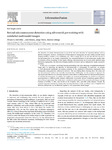Mostrar o rexistro simple do ítem
Retinal Microaneurysms Detection Using Adversarial Pre-training With Unlabeled Multimodal Images
| dc.contributor.author | Hervella, Álvaro S. | |
| dc.contributor.author | Rouco, J. | |
| dc.contributor.author | Novo Buján, Jorge | |
| dc.contributor.author | Ortega Hortas, Marcos | |
| dc.date.accessioned | 2022-02-10T18:05:03Z | |
| dc.date.available | 2022-02-10T18:05:03Z | |
| dc.date.issued | 2022 | |
| dc.identifier.citation | HERVELLA, Álvaro S., et al. Retinal microaneurysms detection using adversarial pre-training with unlabeled multimodal images. Information Fusion, 2022, vol. 79, p. 146-161. https://doi.org/10.1016/j.inffus.2021.10.003 | es_ES |
| dc.identifier.uri | http://hdl.handle.net/2183/29766 | |
| dc.description | Financiado para publicación en acceso aberto: Universidade da Coruña/CISUG | |
| dc.description.abstract | [Abstract] The detection of retinal microaneurysms is crucial for the early detection of important diseases such as diabetic retinopathy. However, the detection of these lesions in retinography, the most widely available retinal imaging modality, remains a very challenging task. This is mainly due to the tiny size and low contrast of the microaneurysms in the images. Consequently, the automated detection of microaneurysms usually relies on extensive ad-hoc processing. In this regard, although microaneurysms can be more easily detected using fluorescein angiography, this alternative imaging modality is invasive and not adequate for regular preventive screening. In this work, we propose a novel deep learning methodology that takes advantage of unlabeled multimodal image pairs for improving the detection of microaneurysms in retinography. In particular, we propose a novel adversarial multimodal pre-training consisting in the prediction of fluorescein angiography from retinography using generative adversarial networks. This pre-training allows learning about the retina and the microaneurysms without any manually annotated data. Additionally, we also propose to approach the microaneurysms detection as a heatmap regression, which allows an efficient detection and precise localization of multiple microaneurysms. To validate and analyze the proposed methodology, we perform an exhaustive experimentation on different public datasets. Additionally, we provide relevant comparisons against different state-of-the-art approaches. The results show a satisfactory performance of the proposal, achieving an Average Precision of 64.90%, 31.36%, and 33.55% in the E-Ophtha, ROC, and DDR public datasets. Overall, the proposed approach outperforms existing deep learning alternatives while providing a more straightforward detection method that can be effectively applied to raw unprocessed retinal images. | es_ES |
| dc.description.sponsorship | This work is supported by Instituto de Salud Carlos III, Government of Spain, and the European Regional Development Fund (ERDF) of the European Union (EU) through the DTS18/00136 research project; Ministerio de Ciencia e Innovación, Government of Spain, through the RTI2018-095894-B-I00 and PID2019-108435RB-I00 research projects; Xunta de Galicia, Spain and the European Social Fund (ESF) of the EU through the predoctoral grant contract ref. ED481A-2017/328; Consellería de Cultura, Educación e Universidade, Xunta de Galicia, through Grupos de Referencia Competitiva, grant ref. ED431C 2020/24. CITIC, Centro de Investigación de Galicia ref. ED431G 2019/01, receives financial support from Consellería de Cultura, Educación e Universidade, Xunta de Galicia , through the ERDF (80%) and Secretaría Xeral de Universidades (20%). Funding for open access charge: Universidade da Coruña/CISUG | es_ES |
| dc.description.sponsorship | Xunta de Galicia; ED481A-2017/328 | es_ES |
| dc.description.sponsorship | Xunta de Galicia; ED431C 2020/24 | es_ES |
| dc.description.sponsorship | Xunta de Galicia; ED431G 2019/01 | es_ES |
| dc.language.iso | eng | es_ES |
| dc.publisher | Elsevier | es_ES |
| dc.relation | info:eu-repo/grantAgreement/MICINN/Plan Estatal de Investigación Científica y Técnica y de Innovación 2017-2020/DTS18%2F00136/ES/Plataforma online para prevención y detección precoz de enfermedad vascular mediante análisis automatizado de información e imagen clínica/ | |
| dc.relation | info:eu-repo/grantAgreement/AEI/Plan Estatal de Investigación Científica y Técnica y de Innovación 2017-2020/RTI2018-095894-B-I00/ES/DESARROLLO DE TECNOLOGIAS INTELIGENTES PARA DIAGNOSTICO DE LA DMAE BASADAS EN EL ANALISIS AUTOMATICO DE NUEVAS MODALIDADES HETEROGENEAS DE ADQUISICION DE IMAGEN OFTALMOLOGICA/ | |
| dc.relation | info:eu-repo/grantAgreement/AEI/Plan Estatal de Investigación Científica y Técnica y de Innovación 2017-2020/PID2019-108435RB-I00/ES/CUANTIFICACION Y CARACTERIZACION COMPUTACIONAL DE IMAGEN MULTIMODAL OFTALMOLOGICA: ESTUDIOS EN ESCLEROSIS MULTIPLE/ | |
| dc.relation.uri | https://doi.org/10.1016/j.inffus.2021.10.003 | es_ES |
| dc.rights | Atribución-NoComercial-SinDerivadas 4.0 Internacional | es_ES |
| dc.rights.uri | http://creativecommons.org/licenses/by-nc-nd/4.0/ | * |
| dc.subject | Deep learning | es_ES |
| dc.subject | Medical imaging | es_ES |
| dc.subject | Multimodal imaging | es_ES |
| dc.subject | Eye fundus | es_ES |
| dc.subject | Generative adversarial networks | es_ES |
| dc.subject | Microaneurysms | es_ES |
| dc.title | Retinal Microaneurysms Detection Using Adversarial Pre-training With Unlabeled Multimodal Images | es_ES |
| dc.type | info:eu-repo/semantics/article | es_ES |
| dc.rights.access | info:eu-repo/semantics/openAccess | es_ES |
| UDC.journalTitle | Fusion | es_ES |
| UDC.volume | 79 | es_ES |
| UDC.startPage | 146 | es_ES |
| UDC.endPage | 161 | es_ES |
| dc.identifier.doi | 10.1016/j.inffus.2021.10.003 |
Ficheiros no ítem
Este ítem aparece na(s) seguinte(s) colección(s)
-
GI-VARPA - Artigos [58]






